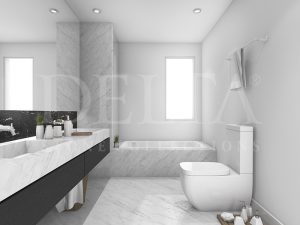Natural stones are known as the symbol of aesthetics, durability and luxury in the decoration and building sector. Among these, travertine and marble are the two most preferred stone types. Let’s see what travertine and marble are, the similarities and differences between them, as well as their usage areas.

What is Travertine?

What is Marble?
Marble is a metamorphic rock formed by the recrystallisation of limestone or dolomitic limestone under high temperature and pressure. During this process, calcite crystals are rearranged, which creates the smooth and shiny surface of marble. Marble has a wide range of colours and unique vein patterns. It can be found in a wide variety of colours such as white, grey, black, green, pink and blue, and the patterns of the veins make each piece of marble unique.
Common Features Between Travertine and Marble
- Being Natural Stone: Both are natural stones, quarried from nature and processed. Therefore, both stones have unique natural patterns and colour variations.
- Durability: Both travertine and marble are durable materials and have a long lifespan. This makes them ideal for flooring and other architectural applications.
- Various Surface Treatment Options: They can be used as polished, honed or filled and the desired appearance can be achieved with different surface treatments.
Differences Between Travertine and Marble
- Structural Properties: Travertine has a porous structure, which gives it a more rustic appearance. Marble, on the other hand, has a smoother and harder surface and generally offers a more polished appearance.
- Formation Process: Travertine is formed by the precipitation of limestone around hot springs, while marble is formed by the recrystallisation of limestone under high pressure and temperature.
- Colour and Vein Patterns: Marble is known for its vein patterns and has a wider range of colours. Travertine, on the other hand, is more often found in natural earth tones and vein patterns are less pronounced.
- Maintenance Requirements: Marble is a more delicate stone than travertine and is more prone to staining when in contact with acidic substances. Therefore, it requires extra care, especially in areas such as kitchen countertops. The porous structure of travertine can be sealed with filler, but still requires regular maintenance and sealing.
Areas of Use
Travertine Usage Areas:
- Travertine Floor Coverings: Thanks to its porous structure, it has anti-slip properties, so it is widely used in outdoor floor coverings, pool sides and garden paths.
- Travertine Wall Coverings: It is preferred for wall coverings to create a rustic atmosphere indoors.
- Travertine Bathroom and Kitchen: Can be used around countertops and sinks, but requires sealing treatment.
Marble Usage Areas:
- Marble Kitchen Countertops: It is one of the indispensable materials of luxury kitchens with its elegance and aesthetic appearance.
- Marble Floor and Wall Coverings: It is used both indoors and outdoors, especially in luxury hotel lobbies, bathroom floors and entrance halls.
- Marble Artistic Applications: It is frequently preferred by sculptors and artists for sculpture and decorative objects.



